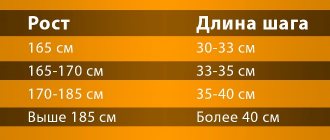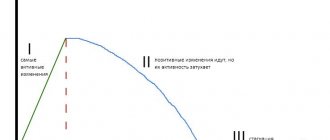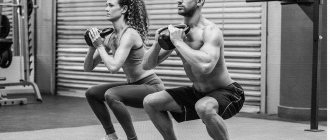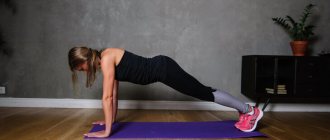- August 5, 2018
- Workouts in the gym
- Nikita Novikov
Do you need breaks from training? What happens if you don't exercise for a long time? How to train after a long rest? All these questions, as a rule, are of interest to novice athletes who have only recently begun to engage in bodybuilding. Taking breaks in training is a very interesting and sensitive topic with a large number of pitfalls. In our article today we will try to give the most detailed answers to frequently asked thematic questions. Interested? Then start reading quickly!
The effect of a break in training on the body
No matter how high a person achieves in fitness, sooner or later the lack of physical activity will affect his body. Due to low physical activity, his energy expenditure will decrease significantly, the central nervous system will calm down, blood flow will decrease, and muscles will relax. The body will eventually come into balance and will spend its resources as much as necessary at that moment.
But there are still certain differences between people who have been training for more than one year and those who have been training for only a few months. We think we won’t surprise anyone if we say that the muscles of experienced athletes are more developed than the muscles of “green” beginners. This means that the degradation of muscle mass and strength in experienced athletes will occur much more slowly than in the second category of people. In addition, muscle memory plays an important role, which allows the athlete to quickly increase lost volumes.
The length of the break in training plays an equally important role. If it lasts several weeks, then in some cases it will have a positive effect on subsequent classes (we will talk about these cases below), and in others, on the contrary, it will lead to a slight deterioration in results. If the break lasts for months or even years, when resuming sports activities a person will essentially have to start all over again. It also matters what kind of lifestyle a person led during his break from training. Smoking, alcohol abuse, poor nutrition - all these factors only accelerate the process of muscle degradation.
How to Speed Up Recovery After a Workout
26.02.2017
There are four phases of recovery: rapid recovery phase, delayed recovery phase, supercompensation and delayed recovery phase. What happens to our muscles at these stages and how can we help them recover faster?
While you're enjoying your workout in the gym and doing sets, your muscles are stressed, stretched and torn.
How to help yourself during training?
- Don’t squeeze all the juice out of yourself: on the contrary, if the load increases, increase the time interval between workouts. The muscles will say “thank you”, and you will see the result much sooner.
- Drink a lot: water restores balance in the body.
- Do some stretching: a cool-down will add flexibility and elasticity to your muscles, remove lactic acid from your muscles and stabilize your pulse.
The rapid recovery phase occurs immediately after training and for 30 minutes after it: the body heals tears and returns the muscles to their original state.
How to help yourself after a workout?
- The best nutrition for muscles is a whey cocktail.
- Keep drinking clean water.
- Take a contrast shower: it will improve blood circulation.
At this time, the functioning of the cardiovascular system is normalized, ATP and glycogen reserves are replenished, and the secretion of stress hormones - cortisol and adrenaline - returns to normal.
The slow recovery phase occurs when the body reaches metabolic equilibrium. The synthesis of proteins, amino acids and enzymes is activated, water and electrolyte balance is restored, nutrients are absorbed, which go towards building damaged cells.
How to help yourself?
- Eat heavily: there should be more proteins and carbohydrates in your diet, but do not exclude fats and vegetables. Vegetables are a source of vitamins and fiber to improve digestion.
- Add sports nutrition: BCAA, gaba, creatine, citrulline and glutamine will saturate the muscles with amino acids.
- Give a massage in the evening: it will improve blood circulation, that is, nutrients and vitamins will be delivered to trained muscles faster.
- Rest: not at the computer or tablet, but in the fresh air before bed.
- Sleep at least 8 hours, or better yet, more! Ventilate the room before going to bed and fall asleep in silence.
Supercompensation occurs 2-3 days after training and lasts up to 5 days. The muscles increase in volume so that they are ready for similar loads in the future. At this moment, it is important to start training again, because the body without loads will return to its previous parameters.
How do you know that your muscles have recovered?
- There will be a burning desire to return to the gym
- Pain and discomfort in the muscles will pass.
The last phase - the delayed recovery phase - will occur if the muscles do not receive the load and return to their previous parameters. However, at this stage you need to be careful: if the muscles do not fully recover, fatigue and overtraining may occur. Overtraining manifests itself first in the form of reluctance to go to training. If you ignore it, you will wake up tired, lose your appetite, and experience stiffness in your joints and muscle congestion. To get rid of these symptoms, you need to rest.
Stages of deterioration in physical fitness during long periods of rest
The decline in strength indicators and a decrease in the athlete’s muscle volume during a break occurs in stages. Reduced activity and lack of training lead to the following stages of detraining:
- Endurance decreases. In the first 2 weeks of a break in training, the level of endurance begins to decrease. Over time, it becomes harder to perform all the exercises, and the number of sets and repetitions begins to decrease. Such processes occur due to a decrease in the rate of blood circulation and the amount of intramuscular energy reserves.
- Muscle volumes decrease. This will be visible to the naked eye. The muscles will decrease in size and lose their former relief. This is due to a decrease in glycogen reserves.
- Decrease in strength indicators. Although visually the muscles will become much smaller, the strength in them will remain for several more months. After this period, it will gradually begin to fall.
Do you need to take breaks from training? Despite the fact that the lack of exercise has many disadvantages, in some cases such rest is simply necessary. We have described the most common reasons in detail below.
Rest time between workouts[edit | edit code]
Optimal training frequency
Read the main article:
How to create a training program
This article is based on the recommendations of Christian Thibado, an experienced weightlifter and specialist in developing training programs.
I don't care how tough and brutal you think you are. The laws of physiology work for everyone. One of these laws states that muscles do not grow through training. No one has ever gained muscle while working out.
When you crawl home after a high-impact workout, you're much worse off than before you hit the gym: you've damaged muscle fibers, you've exhausted your energy reserves, and you've exhausted your nervous system. It is only if you give your body the rest and nutrition it needs that good things will start to happen.
During recovery, your body rebuilds damaged fibers to make muscles bigger and stronger (muscle hypertrophy or tissue remodeling), restores energy reserves with some excess (overcompensation), and the nervous system learns to better recruit motor units (neural efficiency). In short, all good things happen when you don't exercise.
However, many guys don't give their bodies enough rest to progress.
I have my own theory about this, and again I point out that training is very emotional. We become too impatient, trying to quickly create the figure of our dreams. We want to be big and ripped and have superhuman strength, and we want it immediately!
The stronger our desire, the more irrational our behavior and the more time we spend in the gym. There is nothing to be done, we are accustomed to the fact that the more time we spend, the harder we work, the better the result.
Our parents and teachers forced us to spend more time on our lessons, our coaches admonished us with the following maxims: In the dictionary, “success” comes after “work”! When we start working, we also notice that the more hours we work, the higher the salary. How can you blame us for thinking the same way about working out?
Now, you need to stop thinking like that right now, because it's bullshit. The hard fact is that long, intense training will not give you the progress you want without adequate recovery. In fact, you may begin to regress if you plow beyond your recovery capabilities.
Do you know what the stupidest thing people do is when they don't get results from overworking and under-recovery? Do more damn training! They believe that they do not have enough training load. I’ll say it once and won’t repeat it: forget the formula “insufficient progress = insufficient load.” In most cases, especially among highly motivated people, insufficient progress = incorrect load/recovery ratio.
I specifically point this out so that when creating a good program for yourself, you will be sure to include enough rest days and give your body the opportunity to recover and improve. It should be understood that a “rest day” does not necessarily mean a day when you do nothing at all. There are three types of recovery. Let's look at each one.
Active recreation[edit | edit code]
This means you can do something easy that doesn't add stress to your body. This could include playing sports, walking, low-intensity cardio, or even low-intensity iron training. These activities aid recovery by moving blood through damaged muscle fibers and maintaining good metabolism.
The main thing is not to do too much. Some people get so hooked on exercise that they turn even a light workout into a high-intensity workout! This often happens when iron training is used as active recovery. I repeat: active recovery should not add stress to the body.
So if you decide to do a light workout as active recovery, do high reps (12-20 or more) without any failure. Some people also make the mistake of doing interval training or sprints on rest days. Intervals, sprints, plyometrics and similar exercises harm recovery by interfering with both the central nervous system and metabolic processes. As a result, you do not recover from the previous training session with iron and cannot give your best in the next one.
So: on active recovery days, you should not overload your body.
Passive rest[edit | edit code]
This is simply a “day off” where you avoid any physical activity. But don’t let it get to the point of absurdity, you can walk, climb stairs and buy groceries. There is no need to switch to a small electric car that is used by people with large body masses, and there is no need to tell your wife when she asks you to take out the trash, “But, honey, Tib said to avoid physical activity.” A passive recovery day is a normal day in your life, you just don't exercise. That's all I wanted to say about this.
Recovery with the use of auxiliary aids[edit | edit code]
This type includes aids that help your body recover after an intense workout. This could be a massage, Epsom salt baths, contrast showers and the like. For more information, see my article 7 Ways to Speed Up Recovery.
These methods are especially useful in certain circumstances (too much intensity, long workouts, insufficient recovery time, etc.) when fatigue sets in and you are unable to recover between workouts.
Overtraining
Quite often it happens that an athlete, trying to achieve good results, greatly exhausts his body, not allowing it to recover properly. If you add an incorrect diet to all this, then sooner or later the body will become very tired. The first signs of overtraining may be weakness, poor health, lack of muscle growth and strength indicators (or stagnation, as many gym regulars also call it). In such a situation, you can (and even need to!) take a break for a couple of weeks. This technique is also often used by professional bodybuilders, who take a break from sports for 2 weeks 3 times a year. The more experienced the athlete, the longer the rest can last (the main thing is that it does not exceed 4 weeks). As practice shows, after such a break the athlete not only does not lose his previous performance, but, on the contrary, rapidly increases it.
It is worth adding that some training systems allow 1-2 weeks of rest between workouts.
What to do if you want to exercise, but can't?
We are talking about those people who actively go to the gym, but cannot exercise for a long time for a certain reason (vacation, business trip, moving, etc.). In such situations, you should remember a few important rules:
- Do cardio. Run, jump rope, swim in the pool, ride a bike - this will help maintain your endurance at the same level.
- Do exercises with your own weight. These can be pull-ups, squats, push-ups, crunches. Doing these exercises will help you keep your muscles toned all the time.
How to train after a long break?
Even after a long rest, it is much easier to restore muscles and get back into work than during the very first training sessions. But this does not mean at all that it will be easy. As we noted earlier, muscles that were previously well developed decrease in size and lose their former strength. But despite this, they can still be awakened from hibernation. To do this, you need to restore your energy reserves, as well as pay attention to proper nutrition.
The diet should include food rich in quality proteins, carbohydrates, fats, vitamins and minerals. Particular emphasis should be placed on protein, since the formation of muscle fibers depends on it.
Training after a long rest should not be so active, since the body is unaccustomed to previous stress, and the muscles have lost strength and flexibility. Start training 2 times a week for 40-45 minutes, then after about a month increase the number of workouts to three or four. There is no need to rush to take on heavy working weights from the very beginning, as this can quickly drive the body into a state of overtraining or lead to injury, which will force you to take another break from training again.
We can finish here. We hope that with the help of our article we were able to provide answers to the questions that most interest you. We wish you success in sports!
How quickly muscles grow after training
It is believed that the process of repairing damaged fibers begins approximately 2-3 hours after training. This process requires energy and “building material” (proteins), which is why it is recommended to close the “protein-carbohydrate window” after a weight training session. The optimal snack after a fitness lesson is cottage cheese with dried fruits, a turkey sandwich, protein bars, smoothies with cottage cheese and fruits.
The process of muscle recovery lasts approximately 36-48 hours (depending on the muscle group). At this time, it is important not to overload the muscles, sleep enough time, and eat right. The mass of fibers and their cross-sectional area gradually increases. As a result, each individual muscle adapts to the load and begins to work more efficiently - you become more resilient and can handle heavier weights.
How quickly muscles grow from training depends on many factors. “If you do everything correctly, then after about 6-8 weeks of regular exercise you can notice tangible progress,” says Valentin Zinin.
The rate of muscle growth is also affected by training experience. For beginners, in the first six months of training, muscles grow very quickly. “So, a beginner, with proper nutrition and a competent training program, can gain about 2-3 kg of muscle mass in 3-4 months, this is 1-1.5 cm in volume,” says Valentin Zinin.
Over time, the body adapts to the stress, and muscles grow more slowly. However, experts advise focusing not on muscle volume, but on their weight. This parameter can be measured using bioimpedancemetry, an assessment of the qualitative composition of the body. Under ideal conditions, a beginner can gain up to 12 kg of muscle mass per year; on the scales this will look like a “gain” of 15-20 kg. But you shouldn’t chase beautiful numbers - for some asthenic athletes, gaining even 8 kg of muscle per year will be a good result.










